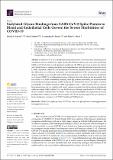Sialylated Glycan Bindings from SARS-CoV-2 Spike Protein to Blood and Endothelial Cells Govern the Severe Morbidities of COVID-19
Author(s)
Scheim, David E.; Vottero, Paola; Santin, Alessandro D.; Hirsh, Allen G.
Downloadijms-24-17039.pdf (3.586Mb)
Publisher with Creative Commons License
Publisher with Creative Commons License
Creative Commons Attribution
Terms of use
Metadata
Show full item recordAbstract
Consistent with well-established biochemical properties of coronaviruses, sialylated glycan attachments between SARS-CoV-2 spike protein (SP) and host cells are key to the virus’s pathology. SARS-CoV-2 SP attaches to and aggregates red blood cells (RBCs), as shown in many pre-clinical and clinical studies, causing pulmonary and extrapulmonary microthrombi and hypoxia in severe COVID-19 patients. SARS-CoV-2 SP attachments to the heavily sialylated surfaces of platelets (which, like RBCs, have no ACE2) and endothelial cells (having minimal ACE2) compound this vascular damage. Notably, experimentally induced RBC aggregation in vivo causes the same key morbidities as for severe COVID-19, including microvascular occlusion, blood clots, hypoxia and myocarditis. Key risk factors for COVID-19 morbidity, including older age, diabetes and obesity, are all characterized by markedly increased propensity to RBC clumping. For mammalian species, the degree of clinical susceptibility to COVID-19 correlates to RBC aggregability with <i>p</i> = 0.033. Notably, of the five human betacoronaviruses, the two common cold strains express an enzyme that releases glycan attachments, while the deadly SARS, SARS-CoV-2 and MERS do not, although viral loads for COVID-19 and the two common cold infections are similar. These biochemical insights also explain the previously puzzling clinical efficacy of certain generics against COVID-19 and may support the development of future therapeutic strategies for COVID-19 and long COVID patients.
Date issued
2023-12-01Publisher
Multidisciplinary Digital Publishing Institute
Citation
International Journal of Molecular Sciences 24 (23): 17039 (2023)
Version: Final published version